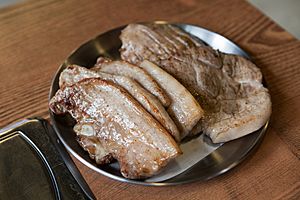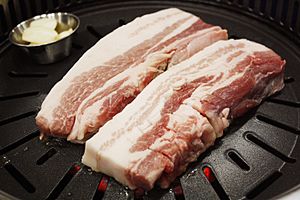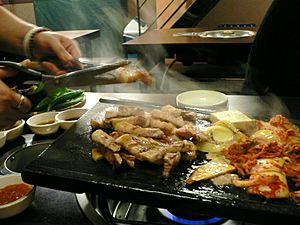Samgyeopsal facts for kids
 |
|
| Alternative names | Samgyeopsal-gui Grilled pork belly |
|---|---|
| Type | Gui |
| Place of origin | Korea |
| Associated national cuisine | Korean cuisine |
| Main ingredients | Pork belly |
| Samgyeopsal | |
| Hangul |
삼겹살
|
|---|---|
| Hanja |
三겹살
|
| Revised Romanization | samgyeop-sal |
| McCune–Reischauer | samgyŏp-sal |
| IPA | [sam.ɡjʌp.s͈al] |
| Hangul |
삼겹살구이
|
| Hanja |
三겹살구이
|
| Revised Romanization | samgyeop-sal-gui |
| McCune–Reischauer | samgyŏp-sal-gui |
| IPA | [sam.ɡjʌp.s͈al.ɡu.i] |
Samgyeopsal (삼겹살) means "three-layer meat." It is also called samgyeopsal-gui (삼겹살구이), which means "grilled three-layer meat." This popular dish is a type of gui, which means a grilled dish in Korean cuisine. It is made from thick slices of pork belly.
Contents
What is Samgyeopsal?
The name samgyeop-sal comes from Korean words. "Sam" means three, "gyeop" means layer, and "sal" means flesh or meat. So, it literally means "three-layer meat." This name describes how the pork belly looks. It has layers of lean meat and fat, making it appear like three distinct layers when cut.
This meat comes from the belly part of a pig. In Korea, when people say samgyeop-sal, they usually mean the grilled version, samgyeop-sal-gui. It's similar to how "ribs" often means "grilled ribs."
There is also a dish called ogyeopsal (오겹살). Here, "o" means five. Ogyeop-sal is pork belly that still has the skin on it. Samgyeop-sal usually has the skin removed.
History of Samgyeopsal
The first time this dish was mentioned was in a newspaper article. It was in the Donga-ilbo newspaper on November 3, 1984. Back then, it was called "segyepsal" instead of samgyeopsal. The name "samgyeopsal" became official in the Standard Korean Language Dictionary after 1994.
Before the 1980s, most Koreans preferred eating beef. However, the government encouraged people to eat more pork and chicken. This was because many cattle were used for farming, so there wasn't enough beef. Big companies, like Samsung, even started their own pig farms to help.
In the late 1980s and 1990s, samgyeopsal became very popular. This happened as companies like Samsung and Lotte started making and selling more meat products. Traditional Korean dishes often used strong spices like ginger and garlic to hide the smell of pork. But as food science improved, the smell problem was solved. This made samgyeopsal even more popular.
In 1996, a new style appeared called "daepae samgyeopsal." This pork belly is cut very thin, like wood shavings made by a tool called a "daepae" (a plane). After the 1998 financial crisis, "Hoesik" culture grew. This is when co-workers go out to eat together after work. Samgyeopsal became a favorite for these gatherings. Later, "beoljip samgyeopsal" appeared. This meat is cut to look like a beehive ("beoljip" in Korean).
Since 2005, the way meat is served on Jeju Island also influenced samgyeopsal. On Jeju, they often serve bigger portions of meat, measured in "geun" (about 600 grams). The popularity of Jeju Black pig meat also grew during this time.
How to Prepare Samgyeopsal
Thick slices of pork belly are grilled right at the table. This is done on a special metal griddle or a grill over charcoal or gas burners. Usually, people grill the meat themselves. They use tongs to flip the meat and scissors to cut it into bite-sized pieces. Then, they eat it directly from the grill.
The meat is often not marinated or seasoned. However, some marinated versions have become popular. These can have flavors like ginseng, wine, garlic, herbs, curry, or chili paste. Slices of garlic, onions, green chili peppers, mushrooms, and kimchi are often grilled alongside the pork. The fat from the pork helps cook these items.
Many side dishes come with samgyeopsal. These include fresh vegetables like lettuce and kkaennip (perilla leaves). There are also pickled radish papers called ssammu. Dipping sauces are important, such as ssamjang (a mix of chili paste and soy bean paste) and gireum-jang (sesame oil with salt and pepper). Other sides include jangajji (soy sauce-pickled vegetables) like pickled Siberian onion leaves or pickled onions. Of course, kimchi is always present. Sliced garlic, onions, and seasoned shredded scallions are also common. You can grill the garlic, onions, and kimchi, or eat them raw with the cooked meat. Mushrooms, like button mushrooms or oyster mushrooms, are also often grilled with the meat.
How to Eat Samgyeopsal
After the meat is cooked, you place a piece on a fresh or pickled vegetable leaf. You can add some ssamjang sauce. Then, you roll it up to make a ssam (wrap). This wrap is meant to be eaten in one mouthful. You can add any of the side dishes you like to your wrap, such as a slice of garlic.
People often eat samgyeopsal with other dishes. These can include cooked rice, stews like kimchi-jjigae or doenjang-jjigae, and naengmyeon (cold noodles). Sometimes, any leftover meat is mixed with rice, gim-garu (seaweed flakes), and seasonings. This makes a delicious bokkeum-bap (fried rice) at the end of the meal.
Popularity of Samgyeopsal
In South Korea, March 3rd is known as "Samgyeopsal Day." This is because the number three relates to the "three-layered" name of the meat. A survey in 2006 showed how much Koreans love this dish. About 85% of adults in South Korea said that pork belly was their favorite cut of pork.
Myth About Samgyeopsal's Health Benefits
There is a common belief in South Korea that eating Samgyeopsal can protect you from air pollution. People thought it helped against tiny particles in the air, sometimes called fine dust. This idea might have started because Korean miners used to eat pork after working hard in mines. However, this is just a myth. In fact, eating samgyeopsal might even help your body absorb harmful chemicals from those particles that can mix with oil.
See also
 In Spanish: Panza de cerdo para niños
In Spanish: Panza de cerdo para niños



